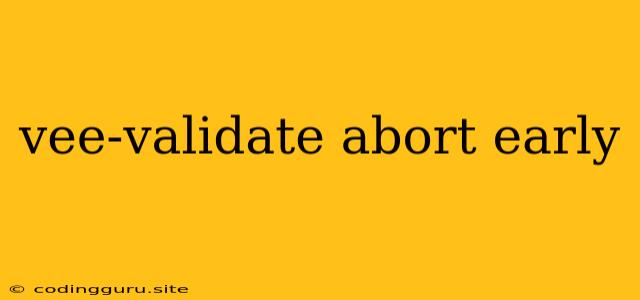Mastering Validation with vee-validate's Abort Early: A Guide to Streamlining Your Forms
Validating user input is crucial in modern web applications. It ensures data integrity, enhances user experience, and prevents errors. Vee-validate, a popular JavaScript validation library, offers a powerful feature called "abort early" that significantly optimizes validation processes. In this article, we'll explore the benefits and mechanics of using "abort early" to build efficient and user-friendly validation systems with vee-validate.
What is "Abort Early" in vee-validate?
Imagine you're validating a form with multiple fields. Each field has its own set of rules. Traditionally, validation would check every rule for every field, even if an error was already found in the first field. This can lead to unnecessary computations and a slower user experience.
"Abort early" in vee-validate addresses this issue. When an error is encountered during validation, it stops the validation process for that field immediately. This prevents subsequent rules from being checked, saving valuable processing time and resources.
Why Use "Abort Early"?
-
Improved Performance: By aborting validation early, "abort early" significantly reduces the time it takes to validate your forms, especially for complex forms with numerous fields and rules.
-
Enhanced User Experience: Faster validation means less time spent waiting for feedback. Users appreciate quick responses and are less likely to feel frustrated by delays.
-
Reduced Code Complexity: "Abort early" eliminates the need to write custom logic to handle premature exits from validation loops, resulting in cleaner and more maintainable code.
Implementing "Abort Early" with vee-validate
Using "abort early" with vee-validate is simple. You need to configure it in your project settings.
1. Installation:
If you haven't already, install vee-validate:
npm install vee-validate
2. Configuration:
In your main application file (e.g., main.js or app.js), import and configure vee-validate:
import { createApp } from 'vue';
import App from './App.vue';
import { Field, Form, ErrorMessage, defineRule, configure } from 'vee-validate';
import * as rules from 'vee-validate/dist/rules';
import * as messages from 'vee-validate/dist/locale/en.json';
configure({
generateMessage: (field, rules) => {
// Customize validation messages here
return messages[rules[0]];
},
validateOnInput: true, // Validate on input
abortEarly: true, // Enable abort early
});
const app = createApp(App);
app.component('Field', Field);
app.component('Form', Form);
app.component('ErrorMessage', ErrorMessage);
Object.keys(rules).forEach(rule => {
defineRule(rule, rules[rule]);
});
app.mount('#app');
3. Using "Abort Early" in Your Forms:
In this example, the form has two fields: email and password. If the email field fails the "required" or "email" rule, validation will stop immediately for that field, preventing the password rules from being checked. This saves time and improves performance.
Conclusion
By leveraging vee-validate's "abort early" feature, you can significantly improve the speed and efficiency of your form validation. This translates to a better user experience, reduced development time, and more maintainable code. Embrace "abort early" and streamline your validation processes today!
